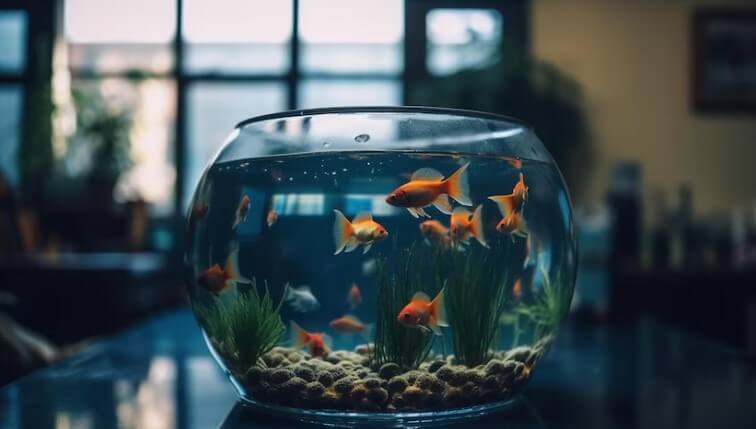A freshwater aquarium isn’t just a tank of water and fish; it’s a meticulously crafted ecosystem that offers a unique blend of aesthetic appeal, educational opportunities, and therapeutic benefits. Imagine being greeted by a captivating aquatic paradise every time you step into your home – a living work of art that soothes the senses and brings the serene beauty of underwater life to your fingertips.
However, before you take the plunge into this aquatic endeavor, it’s crucial to recognize that setting up and maintaining a freshwater aquarium requires more than selecting colorful fish and decorative plants.
In this article, we’ll delve into the fundamental aspects of starting a successful freshwater aquarium.
Table of Contents
Fish Health and Nutrition
Proper nutrition is essential for the health and vitality of your aquatic companions. Different species have varying feeding habits and nutritional requirements. Researching your fish’s natural diet and habits can guide you in selecting the appropriate fish food, like flakes, pellets, or frozen foods, to meet their dietary needs.
Additionally, it’s essential to consider the specific life stage of your aquatic pets when determining their nutritional needs. Like other animals, different developmental stages require different nutrients to support growth, reproduction, and overall well-being.
For instance, young fish that are still growing might need higher amounts of protein to fuel their development. Specialized “fry food” or finely crushed pellets can cater to their small mouths and high protein requirements.
On the other hand, mature fish might benefit from a more balanced diet that includes a mix of proteins, carbohydrates, vitamins, and minerals to maintain their health.
Being prepared for fish health emergencies is essential for responsible fish keeping. Setting up a quarantine tank for new arrivals helps prevent the introduction of diseases to the main tank. Having a well-stocked fish medicine kit and knowing how to administer treatments can make a significant difference in addressing health concerns promptly.
Setting Up Space
Selecting an appropriate location is crucial. Opt for a spot that offers good visibility, allowing you to relish the beauty of your aquatic pets. However, avoid a space with direct sunlight, leading to unwanted algae growth and temperature fluctuations.
Accessibility is also important; choose a location that enables easy access for routine maintenance and care tasks, making the overall upkeep more manageable.
Determining the correct tank size is the next step, and it’s a pivotal one. It’s essential to recognize that different species have distinct requirements regarding tank dimensions. Researching the specific needs of the fish you intend to keep is crucial at this stage.
Consider their adult size, swimming habits, and behavior. Aligning the tank size with the needs of your chosen fish will contribute significantly to their overall health and well-being. Factor in the available space in your home, ensuring the tank fits comfortably and complements the overall aesthetic.
Aquarium Equipment and Essentials
Setting up a thriving aquarium involves assembling a suite of essential equipment. Key components include the tank itself, a reliable filtration system to maintain water quality, a heater to regulate temperature, and appropriate lighting to support the fish and any live plants.
It’s important to balance quality and cost when acquiring equipment. Investing in a well-built, reliable gear might initially seem more expensive, but it pays off in terms of durability, performance, and the overall health of your aquarium.
Cheap equipment might save money upfront, but it can lead to ongoing maintenance issues, fluctuations in water conditions, and potentially harm the well-being of your fish. Researching reputable brands and reading reviews can guide you toward making informed choices that ensure the longevity and stability of your aquarium.
Beyond the essential equipment, exploring optional accessories allows you to infuse your aquarium with personality and flair. Decorations, such as rocks, driftwood, and artificial or live plants, create a visually appealing environment for your fish while serving as hiding spots and territories.
Cycling and Water Quality
The nitrogen cycle is a fundamental process in aquarium maintenance, playing a crucial role in establishing a balanced ecosystem. It involves the conversion of toxic ammonia – released from fish waste and uneaten food – into less harmful compounds.
When setting up your aquarium, kick-starting the nitrogen cycle requires patience. Adding ammonia sources initiates the process by creating an environment where beneficial bacteria can grow.
These bacteria form a colony known as the biological filter. This filter transforms ammonia into less toxic compounds, preventing harmful ammonia levels from accumulating and maintaining a stable nitrogen cycle.
Employ testing kits to regularly measure your tank’s ammonia, nitrite, and pH levels. Recording and tracking these measurements over time helps you detect trends or spikes that might signal an issue. Maintaining suitable water conditions provides your fish with a clean, safe habitat that supports their well-being.
Takeaway
Responsible fishkeeping entails more than just setting up a tank – it involves becoming a steward of a miniature aquatic world. By dedicating time to research, planning, and learning about the needs of your fish, you’re ensuring a healthier and happier environment for them.







